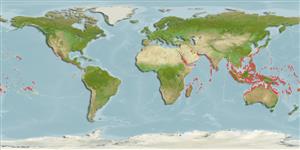>
Ovalentaria/misc (Various families in series Ovalentaria) >
Pomacentridae (Damselfishes) > Chrominae
Etymology: Chromis: Greek, chromis = a fish, perhaps a perch (Ref. 45335).
More on author: Cuvier.
Environment: milieu / climate zone / depth range / distribution range
पारिस्थितिकी
समुद्री प्रवाल-भित्ति संयुक्त; गैर प्रवासी; गहराई सीमा 1 - 20 m (Ref. 86942). Subtropical; 35°N - 35°S
Indo-Pacific: East coast of Africa to the Line Islands and Tuamotu Archipelago; north to Ryukyu Islands, south to the Great Barrier Reef and New Caledonia.
Length at first maturity / आकार / वज़न / Age
Maturity: Lm 5.8 range ? - ? cm
Max length : 10.0 cm TL पुल्लिंग / अलिंग; (Ref. 90102)
पृष्ठीय रीढ़ (सम्पूर्ण): 12; पृष्ठीय सौफट रेज़ (सम्पूर्ण): 9-11; गुदा कांटा 2; ऐनल सौफट रेज़: 9 - 11.
Adults are found in large aggregations above thickets of branching Acropora corals in sheltered areas such as subtidal reef flats and lagoons. Juveniles closely tied to individual coral heads (Ref. 9710). Phytoplankton feeders. Breeding is done on sand and rubble. Males prepare nest for spawning which is shared with several females. Large number of eggs spawned hatching in 2-3 days. Males guard the nest ventilating fertilized egg with their caudal fins and feeding on those which do not hatch. Oviparous, distinct pairing during breeding (Ref. 205). Eggs are demersal and adhere to the substrate (Ref. 205). Diurnal species (Ref. 54980; 113699).
Life cycle and mating behavior
परिपक्व अवधि | पुनरुत्पत्ति | मछलीऔ का अंडे देना | अंडे | Fecundity | लार्वा
Oviparous, distinct pairing during breeding (Ref. 205). Eggs are demersal and adhere to the substrate (Ref. 205). Males guard and aerate the eggs (Ref. 205).
Allen, G.R., 1991. Damselfishes of the world. Mergus Publishers, Melle, Germany. 271 p. (Ref. 7247)
IUCN Red List Status (Ref. 130435)
Threat to humans
Harmless
Human uses
जलजीवालय: व्यापारिक
अधिक जानकारी
संदर्भजलीयकृषिजलीयकृषि रूपरेखाखींचआनुवंशिकीElectrophoresesहैरेटिबिलटीबीमारीप्रक्रमणNutrientsMass conversion
साधन
Special reports
Download XML
इंटरनेट स्रोत
Estimates based on models
Preferred temperature (Ref.
123201): 24.6 - 29.3, mean 28.3 °C (based on 3292 cells).
Phylogenetic diversity index (Ref.
82804): PD
50 = 0.5000 [Uniqueness, from 0.5 = low to 2.0 = high].
Bayesian length-weight: a=0.02089 (0.01266 - 0.03448), b=2.90 (2.76 - 3.04), in cm total length, based on LWR estimates for this species & Genus-body shape (Ref.
93245).
Trophic level (Ref.
69278): 2.9 ±0.1 se; based on diet studies.
लौटाव (Ref.
120179): ऊंचा, न्यूनतम जनसंख्या दुगनी समय अवलागत 15 महीने। (Preliminary K or Fecundity.).
Fishing Vulnerability (Ref.
59153): Low vulnerability (10 of 100).
Nutrients (Ref.
124155): Calcium = 83 [35, 149] mg/100g; Iron = 0.902 [0.484, 1.680] mg/100g; Protein = 18.8 [17.5, 20.1] %; Omega3 = 0.171 [0.087, 0.335] g/100g; Selenium = 10.2 [4.2, 23.0] μg/100g; VitaminA = 86.7 [20.3, 355.3] μg/100g; Zinc = 1.11 [0.66, 1.78] mg/100g (wet weight);
